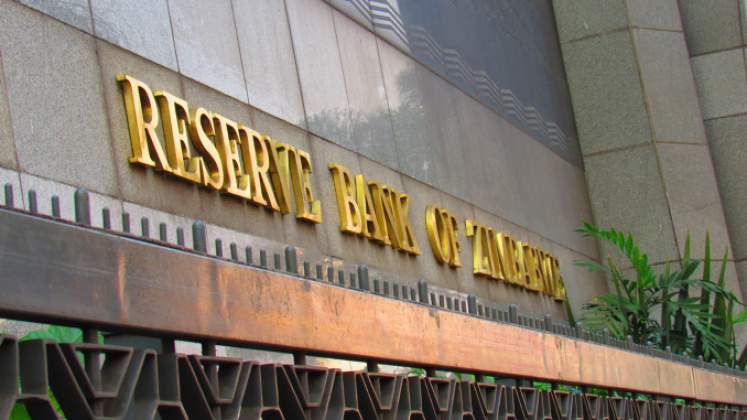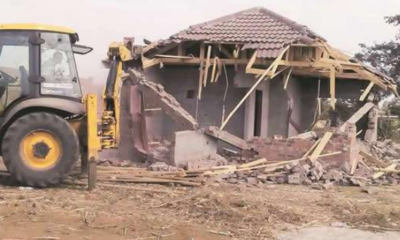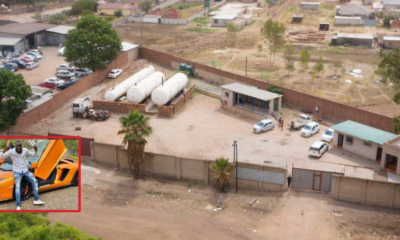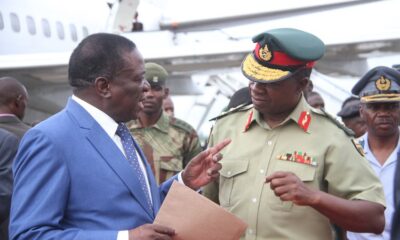
Business
Zim economic chaos difficult to navigate
Published
4 years agoon
By
NewsHawksZimbabwe Investment Notes Edition:
Quarterly Date: October 2020
Issued by: Imara
Asset Management Smoke and Mirrors!
It has become increasingly difficult to analyse the economy by researching the numbers. The same can be said for corporate accounts where hyper inflationary accounting further muddies the picture. Part of our problem is knowing which numbers to trust and believe. The numbers published may not be incorrect but they may not tell the whole story. At the same time, the economic authorities appear to have embarked on a media blitz highlighting that the new auction system has been a huge success and has brought the required stability to prices and the exchange rate. Government statistics have presumably been delayed in their publication by COVID-19; we have only just received the July Monthly Economic Review from the RBZ. This highlights the ZWL economy. Missing from economic data is the growing US dollar cash economy. Therein lies the crux of the issue, there is an informal USD cash economy, an official USD economy and an official ZWL economy! To focus on one, will not provide us with the entire picture.
Far from sitting on our laurels during the ‘lockdown pandemic’ we have been busy interviewing corporate managements virtually to get a better understanding of what is happening in the economy through sales volumes and trading conditions. To a certain extent it opened our eyes to what might be happening in both the ZWL and the USD official and cash economies.
On the face of it, the situation in Zimbabwe could be a lot worse. For now there is food on the supermarket shelves, specialist shops sell luxury items, there is plenty of fuel in the service stations with few to no queues but only if you pay in US dollars. This is a far cry from 2008 when Zimbabwe last experienced hyper-inflation. At that time there were no US dollars and trading in US dollars was illegal. Although Government legally ended the multi-currency system in July 2019, in practice it never really went away and indeed Government has very much supported it in recent months.
We have written in previous Notes about our views that the ZWL would be doomed to failure for anything but a transactional currency. (See also our paper: “Zimbabwe – dollarization and rabbits”
dated April 2020 on the subject). It was introduced at ZWL2.5 to USD1 in February 2019, and one year or so later was worth ZWL100 to USD1. That can hardly be described as a success. Allowing US dollar transactions has essentially saved the day from a supply perspective. If you are fortunate
enough to have or earn US dollars, you can buy most things.
This ‘compromise’ won’t assist the long term future for the Zimbabwe economy however. The entire banking and savings system is built upon the ZWL. We wrote about the decimation of the domestic savings base in our January 2020 Notes. Over recent years the fixed asset base of the Insurance and Pension industry has not been able to keep pace with the devaluation of the ZWL. We estimate that the total valuation of insurance and pension fund assets at about USD1.2 billion at the
end June 2020. Of that liquid assets amount to around USD20 million. That’s simply not sufficient to provide any meaningful investments for the domestic economy. Speaking with a number of the banks whose capital base in US dollars has been close to destroyed, at best the largest loan that could be given amounts to around ZWL500million. That’s little more than US$5 million which barely covers the working capital requirements of one of the larger corporates. Bottom line, it implies that it is close to impossible for the domestic ZWL asset base to fund any large investment or working capital requirements such as the forthcoming agricultural season.
Government can of course guarantee bank loans to the agricultural sector, or indeed it could transfer ZWL to the banks for on-lending to the agri-sector. Since Government is planning a fiscal deficit for 2020 it does not have the capacity to do that without creating ZWL, or printing it. That of course undermines the ZWL further, the resulting devaluation thereby making the banking, insurance and pension industries even less relevant. Government could borrow the money from offshore in foreign currency (and does so) from the likes of Afreximbank but that simply adds to foreign debt that Zimbabwe will find hard to repay.
The latest inflation number for August was 761%. This of course is naturally a ZWL figure. The economic authorities are suggesting that we should be looking instead at a blended rate of inflation, presumably because some products are priced in USD which rarely change and others in ZWL that do. That way inflation would appear lower than it actually is. But this is economic nonsense and we are not aware of such an approach elsewhere in the World. The vast majority of people in Zimbabwe earn ZWL and so ZWL inflation is key. A blended rate might of course look better and perhaps is an attempt to appease those calling for large salary increases to compensate for a real loss
in spending power. It was interesting that Government chose to pay the civil servants with a ‘temporary’ USD allowance of USD75 per month in addition to their ZWL earnings. Initially due to last three months as a cushioning allowance, it has recently been extended to the end of the year. As we wrote in our July Notes, the USD allowance would be paid into civil servants’ new Nostro FCA Domestic bank accounts but they could not then convert those into real USD or transfer the funds outside the country. Initially a swipe card was meant to be connected to this new account but we understand from the banks that this measure was delayed.
Instead the banks convert the funds into ZWL at the auction rate on request for use in the shops. In this regard, the allowance is hedged to some extent to a fall in the official exchange rate (but not the parallel) and so is better than a direct payment in ZWL. The economic authorities meanwhile need to create these nostro balances, which in our July Notes we defined as RTGS dollars, since they are not necessarily backed by real USD. That begs the question as to whether they appear in the monetary numbers and if they do, where are they? Ultimately they will be converted to ZWL and join the formal ZWL economy and the ZWL monetary statistics.
Much of Government’s recent policy actions have centred around the foreign exchange auction system. This was introduced in June with the first rate set at ZWL57 to USD1. At the time the parallel rate was trading at ZWL100 to USD1. The auction rate has since settled around ZWL82, with the gap between the official and parallel rates narrowing to around 30%. The ZWL82 rate has barely moved at all in recent weeks which immediately makes market participants suspicious that the rate is being manipulated. The RBZ controls the auction and supplies the auction with the US dollars that either it has or on behalf of exporters.
Exporters themselves are not allowed to participate in the auction by offering their own export proceeds at an offer price that they determine. Speaking with the corporates who require US dollars, most seem to receive some monies through the auction system, but for those who don’t earn US dollar revenues but who require substantial US dollars for inputs, licences or capex, the auction system is wholly inadequate for larger amounts of foreign exchange. A market-based foreign exchange market would allow an exporter to sell the necessary US dollars to the domestic importer but the exchange rate would likely be very different from the auction rate and more in line with the parallel rate. The RBZ appears unprepared to allow that for the time being.
The demand for US dollars through official channels has fallen substantially now that the RBZ and the economic authorities have allowed businesses to charge for their services in both US dollars and ZWL – so long as the foreign exchange rate used is set at the auction rate. In reality we suspect that this will not necessarily be the case for USD cash transactions. This new policy has
been a saviour for businesses who can in many instances earn sufficient US dollars for their own needs without the need to access the auction market. We have spoken with a number of businesses across different sectors; US dollar sales represent in the majority of cases around 50% of revenues, but in some cases as high as 75% or more. Further, the bulk of fuel is now charged in USD which implies the RBZ does not have to find foreign exchange for the purposes of importing fuel.
Government wants a slice of the action too demanding that tax on forex revenues be paid in forex and not ZWL. Further 20% of forex domestic nostros must be handed over to the RBZ for their use in return for ZWL at the auction rate. If the Government was serious about de-dollarisation, it would insist on tax being paid in ZWL forcing businesses to convert their US dollars into ZWL in the foreign exchange market. Clearly the economic authorities have little faith in the ZWL, preferring instead foreign exchange. For businesses earning the USD cash, there will of course be an incentive to under disclose any revenue earned in this way. Zimra for one will be the loser.
Another advantage for businesses being able to sell in USD is that they can pay employees a portion of their wages in USD. This will to some extent help to alleviate the brain drain that Zimbabwe suffered back in 2007/2008. Of course businesses that only earn ZWL revenues will be unable to do that; the entire financial sector is a case in point. Retaining staff will prove tough in such businesses; where employees won’t need to leave the country to earn foreign exchange as they did in 2007/2008, they can simply change sectors!
Speaking with business people today as compared with our discussions in May/June, is like comparing chalk and cheese. Back in May, businesses were struggling to emerge from a harsh lockdown. Sales were in ZWL, business hours were reduced, productivity was low and accessing foreign exchange was tough given an artificial exchange rate peg of ZWL25 to USD1. Those same business people are now far more optimistic, as capacity utilization is rising, revenues are in both USD and ZWL, accessing foreign exchange for inputs is easier, creditors can be paid off and so forth. But that optimism is off a very low base with the July to September quarter that much better. To put it into perspective, as one business person put it, their volumes were down 50% on a year ago during the first half of 2020, but last year’s volumes were 50% off the year before! So whilst the latest quarter has seen a substantial improvement, we are far from the peaks of 2018/2019.
A simple analysis of activity over recent years would highlight that volumes in 2018 were high and in some businesses (e.g. Delta) at an artificial peak as the economy was operating under the ‘one to one’ illusion where RTGS prices were too low in USD terms. When the illusion started to shatter from October 2018 and then with the advent of
the new ZWL at ZWL2.5 to USD1 in February 2019, demand started to fall. It then collapsed in July 2019 when the multi-currency system was made illegal and selling products or services in USD was banned. March 2020 saw the start of the COVID-19 lockdown, with demand collapsing further. So the most recent quarter’s optimism should be put into some sort of perspective!
Whilst the short term may be improving, the longer term prospects remain constrained. After all, ZWL salaries in real terms are at best 70% lower than they were, so volume demand has necessarily collapsed. Those who can access USD cash will be better off but that cash will be coming from under mattresses or from within the informal economy. There is little chance that much of it will end up in the financial system. The general populace once again does not trust the formal financial system having had their USD savings ‘stolen’ when their USD assets and cash were forcefully converted from USD into RTGS in 2018/2019. Which brings us back to the size of the banking system as compared to the real economy.
It is simply not large enough to finance the economy. The same can be said for the Government’s own income in real terms. It is small relative to 2017/2018. The temptation to print money to fund infrastructure programmes or agriculture will be all too great and hence we remain highly skeptical that the current stability in the ZWL can last. Then again, the ZWL economy as compared with the USD formal and informal economies has and will continue to decline in relevance as the multi-currency system takes hold once again. So analyzing the ZWL data will overtime become a pointless exercise – if it isn’t already.
It is nevertheless interesting – and maybe for amusement – to look at some ZWL monetary data as published by the RBZ last week, being the July Monthly Economic Bulletin. As we have highlighted above, it only tells a part of the story. The RBZ monthly statistics co-mingle different currencies –
ZWL, USD domestic nostro etc. – but not with the US dollar itself. A more serious distortion creeps in thanks to the use of the official auction rate to translate foreign assets and liabilities against a hyperinflationary background. It is impossible to guess where a truly floating exchange rate would settle if exporters could participate at the auction directly without the central bank acting as a go
between to set the offer rate, but with the auction rate consistently 30% or so over-valued compared to the parallel rate, the statistics are clearly distorted. The official statistics show just what damage there has been to the financial sector; when translated back into US dollars the total assets of the banking system amount to just US$2.8bn and total loans a paltry US$430m.
Both Reserve Money (M0) and Broad Money (M3) have been growing quickly but this is to a large extent due to the translation of various currency items into ZWL. For example, foreign currency
deposits in the depository institutions (i.e. mainly the banks) have risen to 60% of M3 (as at the end of July 2020) which compares to 24.4% in July 2019 as the ZWL has devalued. [Various definitions of “dollarisation” exist, but one IMF research document (see “Dollarisation in Sub-Sahara Africa: Experience and Lessons”) would regard a 30% threshold of foreign currency deposits as a share of total banking deposits to be dollarisation.] Using the central bank’s official exchange rates, M3 was US$1.85bn in July 2019 and US$1.71bn in July 2020 i.e. flat. It was US$1.25bn using the parallel rate, i.e. a one-third collapse in broad money over the year and which possibly more accurately reflects the true fall in real GDP. Our corporate interviews would largely agree with this number. A typical sub-Saharan country would demonstrate a broad money to GDP ratio of between 20%-30% – Zimbabwe’s was 32% in 2018 compared to 22% for Zambia for example. At the auction rate, this range would suggest Zimbabwe’s formal ZWL GDP is today around USD6bn or US$400 per head assuming 15m people. This is roughly one-tenth of the threshold level for Middle Income status of US$4,000.
Figures on reserve money are now being published weekly – which hints that this is therefore a fairly “harmless” number to let into the public domain. Reserve money grew by 3.9x in the year to July 2020, whereas M3 grew by 7.8x and the official CPI rose by 8.3x. The exchange rate rose by 8.3x (i.e. it devalued by 88%) so it is easy to see reserve money is fairly irrelevant as an indicator whereas M3 is far more correlated to inflation and devaluation. In passing, there is a target for reserve money, but this has changed reasonably frequently – it is now a growth of 25% q-o-q from 15% y-o-y at the start of 2020. Goodhart’s Law – named after Charles Goodhart who was a member of the Bank of England’s Monetary Policy Committee – covers this: “when a measure becomes a target, it ceases to be a good measure.” What is interesting though is how the pace of devaluation and the rise in the CPI tracks M3 even though M3 is published with a considerable lag, currently over two months.
One number that stands out from the RBZ Survey is the rise in Central Bank liabilities to non-residents (i.e. foreign debt). These are translated at the official exchange rate and have risen from US$0.29bn in July 2019 to US$5.07bn (as of July 2020). The big rise occurred during Q1 2020 such that by April 2020 liabilities to non-residents amounted to US$4.36bn. Two possible explanations spring to mind although the lack of an official explanation has inevitably given rise to speculation. The first is external borrowing collateralised by future mineral output to pay for domestic spending (food imports etc.) and to kick start the auction system that started in late June. The fall in these liabilities of around US$100m between June and July could reflect a run-down of foreign exchange to supply the auction which has seen turnover of around US$100million per month.
This however is a modest number compared to the rise in liabilities to non-residents between July 2019 to date. The second explanation is that this reflects the legacy debt issue. If so, and assuming GDP (for the formal ZWL economy) really is in the region of US$6bn, then these liabilities to non
residents must surely be reaching some kind of prudential limit for the institutions that have supplied this debt. Either way, corporates have had two major incentives to hoard ZWL – leading to the tight ZWL monetary conditions we saw recently; the first was to raise ZWL to put onto the RBZ at 1:1 as legacy debt, and the second was to pay for foreign exchange at the auction rate at a 30% discount to the parallel rate. Our ‘bottom-up’
micro meetings suggest that corporates are now just about able to live with a 70% retention ratio, so the immediate pressure on ZWL liquidity is reduced. It will tighten again if inflation and the parallel rate start to move while the auction rate remains fixed.
The sum of Net Foreign Assets – of which Central Bank liabilities to non-residents is a component – and Net Domestic Assets is Reserve Money. So as these components change, so reserve money changes. An inflow into the country will increase reserve money and an outflow will reduce reserve money and tighten monetary conditions. But, it remains hard to believe the RBZ can produce a figure for reserve money weekly without also producing a full balance sheet; that would be more useful.
The mere fact that foreign debt has risen so much in 2020 suggests that at least some financial institutions are willing to lend that money to Zimbabwe. It is far more than would be received from the Paris Club or the IMF under normal
circumstances should they have been able to lend. The loans though would not be concessional as the multi-laterals would provide, but on commercial terms which is far more expensive. One can also make the point that the mantra that Zimbabwe is suffering due to sanctions does not follow. If it did foreign debt would not have increased in 2020 to the extent that it has! The very fact that there have been net foreign inflows may explain the relative stability in the parallel rate over recent months. We doubt however that these inflows are sustainable over the medium to long term.
Zimbabwe may have escaped relatively unscathed health wise from the COVID-19 crisis that has battered the World. Once again the official data may not be as comprehensive as in the western World. Speaking with the companies we have heard that their employees have suffered relatively little from the virus. One company tested all of its employees, numbering into thousands, utilizing the PCR test. Just over 1% tested positive and of that number, 50% showed no symptoms whilst the other 50% had mild symptoms. This ratio of asymptomatic cases is in line with global data (up to 80%) suggesting that the effect of the virus circulating in Zimbabwe is
no different to the rest of the world but that some special factors have reduced the incidence of the spread in Zimbabwe. Zimbabwe’s lockdown has not been as harsh as say South Africa. April and May were closed down, but the easing was relatively rapid from June, and those in ‘essential services’ appeared to be many; mining, agriculture, food supplies, medicine, financial services could all operate during the first lockdown. The scientists can work out if and why Zimbabweans have not been affected as much; whether it was the sunny winter weather (Vitamin D), the BCG injections that every child in Zimbabwe receives which may have built a stronger immune system or an early lockdown that closed the borders. We are not qualified to comment.
We hope we have highlighted in these Notes in some way the difficulties of analysing the Zimbabwe economy in October 2020. The smoke and mirrors that can be used by the economic authorities to present a picture of the economy are many; they may not be lying in terms of the data, but the data simply does not tell the whole story. Our focus will therefore continue largely on our discussions with management that have to deal with the day-to-day issues within their businesses. That should give us a much better understanding of the economy as a whole.
The current ‘multi-currency system’ as it stands today could be with us for a while but over time we would expect the ZWL economy to represent a decreasing share of the overall Zimbabwe economy. Overall economic growth will be constrained by the availability of US dollar cash within the economy which won’t change until such time as the financial system redollarises and starts to lend again. But even then, who would trust their real dollar savings in a locally based financial institution under current circumstances?
As far as the investment climate is concerned foreign investors have continued to sell the ZSE taking advantage of the auction system to repatriate their proceeds now that the Old Mutual mechanism is no longer an option. It is unlikely they will return any time soon. After the disastrous first decade of the new millennium that culminated in hyper-inflation and a violent 2008 election, foreigners – as with most Zimbabweans – genuinely thought the Government of National Unity together with a US dollar monetary system would finally allow Zimbabwe to turn over a new leaf and grow rapidly. Foreigners invested heavily as a result driving the ZSE to new heights in 2013. By 2016, the US dollar system had been infiltrated by unbacked RTGS dollars which weakened the monetary system and eventually broke it, culminating in the introduction of the ZWL in February 2019. As we wrote in our April Notes:
‘By introducing the ZWL in February 2019 and converting all RTGS dollar assets and liabilities into ZWL assets and liabilities, Government successfully stopped Financial Dollarisation by
making it illegal. Prior to that time, an RTGS dollar was officially at par with the USD although in reality that was not the case. The effect of redenominating assets and liabilities into ZWL was to enable the government to fund itself again by printing money and/or Treasury Bills and to rescue the banking sector. The flip side of such a policy was to break the illusion that Zimbabwe supported property rights, the fundamental backbone of a modern economy. Whilst in 2002, around 4,500 commercial farmers lost their property rights with the farm invasions, the entire population together with foreign investors lost their monetary property rights as their US dollars were exchanged for ZWL paper. All at a stroke of a pen.’
Once bitten, twice shy – there are plenty of other attractive places for foreigners to invest their funds. Sadly they have been bitten by Zimbabwe once too many times for them to be able to justify to their own trustees that this time will be different.
For domestic investors who don’t have access to US dollars, the ZSE remains the only viable option for new investment or as a hedge since money market assets will lose value over time. Sadly investment options on the market have been reduced by Government’s insistence that Old Mutual, Seed Co International and PPC Ltd be suspended and ultimately relisted on a new exchange in Victoria Falls. A number of corporate actions are in the pipeline which will see a number of other companies delist or absorbed into their
parent companies. Overall that will reduce the available liquidity on the ZSE.
We have to be very aware of the risks of holding any ZWL asset that could lose all of its value as occurred in 2009. The ZSE has risen strongly so far this year in US dollar terms and has at last proved a great hedge against the devaluation. Hard assets such as property and equities listed on the ZSE therefore make up a larger proportion of pension and insurance fund assets as monetary assets, including prescribed assets, have lost substantial real value over the past few years.
Despite the USD gains on the ZSE so far this year, asset values based in US dollars remain very low by historical standards and arguably are lower now than they were when the economy crashed in 2008. With business conditions now improving post lockdown and with the re-introduction of the multi-currency system albeit by default, we expect to see strong gains in volume growth and profitability from the current very low base. That should sustain the gains in equities once the foreign selling ends. There are some excellent businesses in Zimbabwe which we can be part owners of via the ZSE. Our regular corporate interviews give us much encouragement despite the economic challenges that we are all experiencing.
John Legat,
Chief Executive
Imara Asset Management (Zimbabwe) Ltd
You may like








